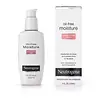What's inside
What's inside
 Key Ingredients
Key Ingredients

 Benefits
Benefits

 Concerns
Concerns

 Ingredients Side-by-side
Ingredients Side-by-side

Water
Skin ConditioningDicaprylyl Carbonate
EmollientEthylhexyl Stearate
EmollientGlycerin
HumectantCocoglycerides
EmollientSqualane
EmollientSodium Polyacrylate
AbsorbentButyrospermum Parkii Butter
Skin ConditioningCeramide NP
Skin ConditioningCeramide AP
Skin ConditioningCeramide As
Skin ConditioningCeramide Ns
Skin ConditioningCeramide EOP
Skin ConditioningSodium Hyaluronate
HumectantAdenosine
Skin ConditioningPalmitoyl Tripeptide-5
Skin ConditioningCitrullus Lanatus Seed Oil
EmollientGlyceryl Stearate
EmollientCaprylyl Glycol
EmollientHydroxyacetophenone
AntioxidantSodium Stearoyl Glutamate
CleansingHexylene Glycol
EmulsifyingTocopherol
Antioxidant2,3-Butanediol
HumectantXanthan Gum
EmulsifyingEthylhexylglycerin
Skin ConditioningSodium Phytate
Sodium PCA
HumectantUrea
BufferingHydrogenated Lecithin
EmulsifyingTrehalose
HumectantPolyquaternium-51
Skin ConditioningTriacetin
AntimicrobialCholesterol
EmollientPhenoxyethanol
PreservativeWater, Dicaprylyl Carbonate, Ethylhexyl Stearate, Glycerin, Cocoglycerides, Squalane, Sodium Polyacrylate, Butyrospermum Parkii Butter, Ceramide NP, Ceramide AP, Ceramide As, Ceramide Ns, Ceramide EOP, Sodium Hyaluronate, Adenosine, Palmitoyl Tripeptide-5, Citrullus Lanatus Seed Oil, Glyceryl Stearate, Caprylyl Glycol, Hydroxyacetophenone, Sodium Stearoyl Glutamate, Hexylene Glycol, Tocopherol, 2,3-Butanediol, Xanthan Gum, Ethylhexylglycerin, Sodium Phytate, Sodium PCA, Urea, Hydrogenated Lecithin, Trehalose, Polyquaternium-51, Triacetin, Cholesterol, Phenoxyethanol
Water
Skin ConditioningCyclomethicone
EmollientCetyl Ethylhexanoate
EmollientGlycerin
HumectantCetyl Ricinoleate
EmollientStearyl Alcohol
EmollientGlyceryl Stearate
EmollientPEG-100 Stearate
Methyl Methacrylate
Glycol Dimethacrylate Crosspolymer
Lysine Carboxymethyl Cysteinate
Skin ConditioningLysine Thiazolidine Carboxylate
Skin ConditioningTocopherol
AntioxidantSilica
AbrasiveXanthan Gum
EmulsifyingMethylparaben
PreservativePropylparaben
PreservativeDiazolidinyl Urea
PreservativeBenzalkonium Chloride
AntimicrobialWater, Cyclomethicone, Cetyl Ethylhexanoate, Glycerin, Cetyl Ricinoleate, Stearyl Alcohol, Glyceryl Stearate, PEG-100 Stearate, Methyl Methacrylate, Glycol Dimethacrylate Crosspolymer, Lysine Carboxymethyl Cysteinate, Lysine Thiazolidine Carboxylate, Tocopherol, Silica, Xanthan Gum, Methylparaben, Propylparaben, Diazolidinyl Urea, Benzalkonium Chloride
 Reviews
Reviews

Ingredients Explained
These ingredients are found in both products.
Ingredients higher up in an ingredient list are typically present in a larger amount.
Glycerin is already naturally found in your skin. It helps moisturize and protect your skin.
A study from 2016 found glycerin to be more effective as a humectant than AHAs and hyaluronic acid.
As a humectant, it helps the skin stay hydrated by pulling moisture to your skin. The low molecular weight of glycerin allows it to pull moisture into the deeper layers of your skin.
Hydrated skin improves your skin barrier; Your skin barrier helps protect against irritants and bacteria.
Glycerin has also been found to have antimicrobial and antiviral properties. Due to these properties, glycerin is often used in wound and burn treatments.
In cosmetics, glycerin is usually derived from plants such as soybean or palm. However, it can also be sourced from animals, such as tallow or animal fat.
This ingredient is organic, colorless, odorless, and non-toxic.
Glycerin is the name for this ingredient in American English. British English uses Glycerol/Glycerine.
Learn more about GlycerinGlyceryl Stearate is a mix of glycerin and stearic acid.
It is used to stabilize the mixing of water and oil ingredients. By preventing these ingredients from separating, it can help elongate shelf life. It can also help thicken the product's texture.
As an emollient, it helps soften skin and supports barrier-replenishing ingredients.
In cosmetics, Glyceryl Stearate is often made from vegetable oils or synthetically produced.
This ingredient may not be fungal-acne safe
Fun fact: The human body also creates Glyceryl Stearate naturally.
Learn more about Glyceryl StearateTocopherol (also known as Vitamin E) is a common antioxidant used to help protect the skin from free-radicals and strengthen the skin barrier. It's also fat soluble - this means our skin is great at absorbing it.
Vitamin E also helps keep your natural skin lipids healthy. Your lipid skin barrier naturally consists of lipids, ceramides, and fatty acids. Vitamin E offers extra protection for your skin’s lipid barrier, keeping your skin healthy and nourished.
Another benefit is a bit of UV protection. Vitamin E helps reduce the damage caused by UVB rays. (It should not replace your sunscreen). Combining it with Vitamin C can decrease sunburned cells and hyperpigmentation after UV exposure.
You might have noticed Vitamin E + C often paired together. This is because it is great at stabilizing Vitamin C. Using the two together helps increase the effectiveness of both ingredients.
There are often claims that Vitamin E can reduce/prevent scarring, but these claims haven't been confirmed by scientific research.
Learn more about TocopherolWater. It's the most common cosmetic ingredient of all. You'll usually see it at the top of ingredient lists, meaning that it makes up the largest part of the product.
So why is it so popular? Water most often acts as a solvent - this means that it helps dissolve other ingredients into the formulation.
You'll also recognize water as that liquid we all need to stay alive. If you see this, drink a glass of water. Stay hydrated!
Learn more about WaterXanthan gum is used as a stabilizer and thickener within cosmetic products. It helps give products a sticky, thick feeling - preventing them from being too runny.
On the technical side of things, xanthan gum is a polysaccharide - a combination consisting of multiple sugar molecules bonded together.
Xanthan gum is a pretty common and great ingredient. It is a natural, non-toxic, non-irritating ingredient that is also commonly used in food products.
Learn more about Xanthan Gum